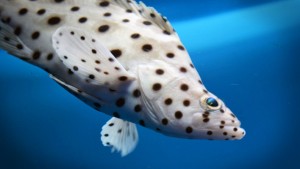There is no hard-and-fast rule regarding the space requirements for fish in captivity. Indeed, this value varies greatly from one species to the next. However, instead of relying on guesswork, try the following method to accurately assess the space needs of your fish as they grow:
1) Determine the maximum adult size of the fish
This can be done by looking up the species at www.fishbase.org. There you’ll find the maximum recorded length for that species in the wild.
An informal study at one public aquarium showed that, on average, long-term captive fish typical of those housed in home aquariums reached only 66 to 75% of the maximum length for that species listed on FishBase. Therefore, multiplying the given maximum length by 0.75 will give a reasonable estimate of how large that species will grow in an aquarium. If this value is greater than 80% of the width of the aquarium you have available, then that species will definitely grow too large for those accommodations (the fish need to be able to turn around freely).
The depth of the aquarium is not as critical a factor, as all commercially built aquariums are sufficiently deep for the fish they are intended to house. The only time an aquarium might be too shallow is in the case of a custom-built tank of odd dimensions. In those cases, the height of the fish needs to be less than 50% of the tank’s depth.
2) Measure the open space of the aquarium (not filled with rocks or other decorations)
Add the length and the width (front to back) of the tank. This number (L+W) is then divided by the maximum captive size of the fish you already determined. The resulting number must be greater than 4, but greater than 6 would be even better. If the number is less than 4, this species is capable of outgrowing that particular aquarium and should not be acquired.
For example, the panther grouper (Cromileptes altivelis) is reported by FishBase to reach a length of 70 cm. Multiplying that by 0.75 gives an estimated captive adult size of 53 cm, or 21 inches. Suppose the available aquarium is 3 feet wide by 6 feet long. The 21-inch maximum fish size is less than 80% of the 36-inch tank width, so the fish passes that test. The aquarium’s length plus width is 108 inches. Dividing that by the 21-inch maximum fish length gives a result of 5.1, or just barely large enough to house an adult panther grouper.
Exceptions to the rule
There are exceptions to this formula:
- Eels don’t need as much swimming space as their long length might indicate.
- Active swimmers, such as surgeonfish and sharks, need more open swimming space, with numbers greater than 8 being required.
Additionally, these calculations do not factor in carrying capacity, in other words, how many other fish the aquarium can hold at the same time.
Minimally speaking
Understand that this calculation determines only the minimum size aquarium needed to house a particular species of fish, not the optimal size. Many aquarium detractors might ask, “How can a fish be happy in an aquarium when they had the whole ocean to swim in?” Of course, fish don’t utilize the “whole ocean” and who truly can tell whether a fish is “happy” or not?
What aquarists need to be mindful of is that the size of the aquarium used to house their fish must be large enough so the fish can live their entire lives there without developing the “artifacts of captivity” that occur when a fish is kept in an undersized aquarium, such as bent fins, bruised snouts, or damaged eyes.



